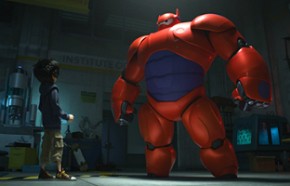Leaving guyland

In Guyland: The Perilous World Where Boys Become Men, Michael Kimmel writes about cultural pressure on young men to obey rules that prohibit them from showing emotion or any sign of weakness. Movies and stories for little boys tend to train them to act according to this concept of what it means to be male. In much of popular culture, men are reduced to animals, to testosterone, with little room to acknowledge themselves as God’s image bearers.
But there are glimmers of hope.
The animated film Big Hero 6 opens with a boy named Hiro who gets himself into mortal peril in the sort of truncated “guyland” where emotion is forbidden and violence glorified. The setting is a city called San Fransokyo, where big, dangerous men are betting big, dangerous money on robot fights. Hiro slips in with a feigned wide-eyed innocence and a remarkable little robot he has built.





